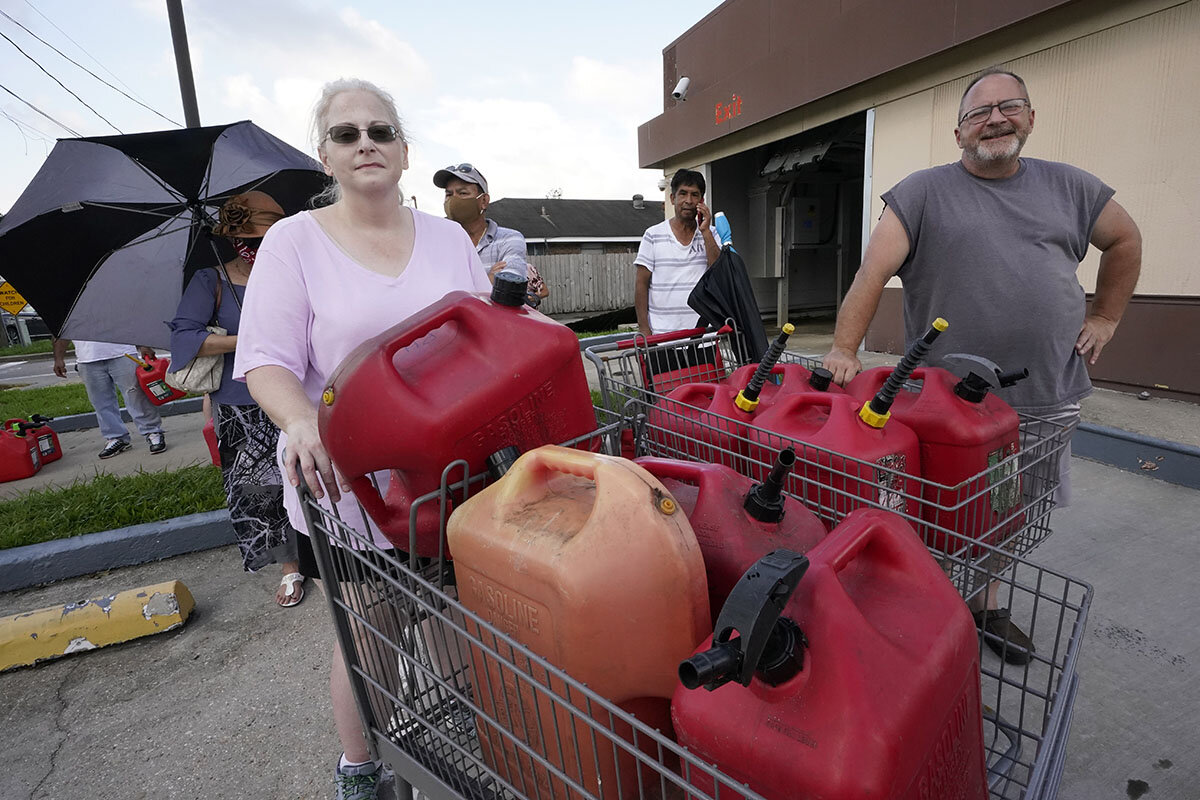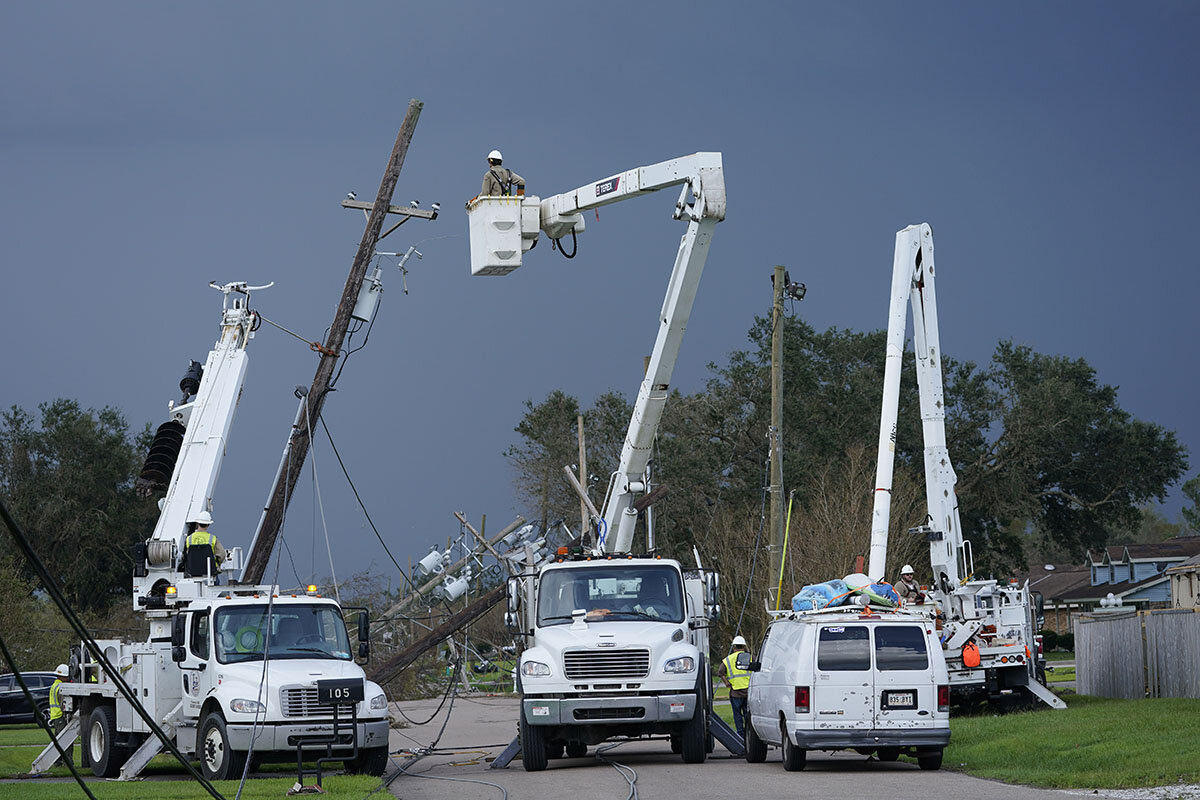After Ida, Louisianians help one another, wait for official aid
Loading...
| New Orleans; and Kirbyville, Texas
The day before Ida made landfall as a Category 4 hurricane, President Joe Biden approved Louisiana Gov. John Bel Edwards’ request for an emergency disaster declaration. From the perspective of New Orleans residents in the days after the storm, we couldn’t tell. Emergency personnel weren’t yet roaming our neighborhood, minus a few local police officers. Our neighbors had become our only lifelines.
Many nonprofit organizers across New Orleans have begun to wonder when help might finally come as days are beginning to bleed into an entire week since the storm hit the Crescent City.
Hurricane Ida knocked out the power for more than 1 million customers across the Gulf Coast, primarily in Louisiana. On Monday, Entergy, the Bayou State’s largest utility company, said it could be weeks before power is restored after the storm took out all eight transmission lines running energy into Greater New Orleans. Two have so far been restored, Entergy announced earlier today.
Why We Wrote This
In the wake of Hurricane Ida, a region is showing its resolve as residents and nonprofits help one another in hard-hit Louisiana. But questions also run deep over whether government help is falling short – just as it did after Katrina 16 years ago.
The Federal Emergency Management Agency has been working alongside state officials and the National Guard to distribute food, water, and tarps and to assist with post-storm rescues. Regarding the widespread power outages, FEMA officials have described progress in getting emergency generators in place for critical infrastructure like water treatment plants.
Yet despite such efforts, many people in New Orleans and throughout the region are mostly fending for themselves, nonprofit organizers say. Complicating matters is that residents are being left to do so as the temperature hits a sweltering 100 degrees with humidity. A heat advisory has been put in place. Local officials have set up services such as phone-charging and cooling stations, feeding sites and meal distribution, and transportation to shelters for those who are unhoused.
But local and state resources are limited, leaving local residents to leap into action, as well as community nonprofits that have become adept at responding to these types of crises in the city.
“I think in general, this has just been a really incredible example of how effective mutual aid is. ... People are helping each other, like distributing food and water and sharing generator access,” says Delaney Nolan, an organizer with Southern Solidarity, a volunteer group that supports unsheltered people in New Orleans. “What I’ve not seen is even a single member of the National Guard, or police, or state people, give out even a single bottle of water.”
“We have to be our own saviors”
Gaps in government support mean that many here feel desperate for more federal assistance, even as some are resigned to the big role that self-help is playing.
“No one can take care of New Orleans like New Orleans can,” says Erica Chomsky-Adelson, executive director of Culture Aid NOLA, the city’s only no-barrier food distribution group. The organization has supplied 1.5 million pounds of food to residents since the COVID-19 pandemic began last year. “We are the first responders. We have to be our own saviors. No one else can do that for us.”
As a reporter who lives in the city, I saw the community response firsthand.
Only a few in my neighborhood decided to stick out the storm. But by midday Monday, after Ida had left Louisiana in its destructive path – amounting to one of the strongest hurricanes in U.S. history, with more than 8 inches of rainfall and winds up to 150 mph in some parts of the state – our block understood that the clock was ticking for us to do something with the food that was gradually defrosting and spoiling in our freezers and refrigerators.
So, for a moment that day, we ate barbecued chicken and fresh grouper from the Gulf of Mexico together. As community members, we were already there for each other.
Y’all have enough water over there? ... We have some charcoal and lighter fluid to spare if you need it. ... Here, take a few dollars ... Is there anything we can help with? ... Come back later for some food, y’all.
New Orleans was not alone in taking Hurricane Ida’s brunt force over the weekend. In places like the town of LaPlace in St. John the Baptist Parish, the roofs blew off some homes, and on social media, desperate families began posting their addresses and the number of adults and children in the homes, begging for help to arrive.
Governor Edwards, who viewed the damage by helicopter Tuesday morning, said roughly 800 St. John the Baptist Parish residents were rescued – some by law enforcement and some by a ragtag group of volunteers who call themselves the Cajun Navy.
On Thursday, as people from New Orleans to more rural areas struggle to regroup, President Biden himself joined voices saying more help is urgently needed.
“We know that there is much to be done in this response on our part,” Mr. Biden said at the White House earlier today. “We need to get power restored. We need to get more food, fuel, and water deployed.”
Prior to Ida’s landfall, cable TV news hosts breathlessly noted how the storm would hit New Orleans on the 16th anniversary of Katrina’s havoc, when the levees broke, flooding the city. More than 1,800 people across the region lost their lives during Katrina.
The echoes of Katrina
Ida proved far less damaging than Katrina in lives lost – of about 25 so far, most have been due to flooding far inland and north of Louisiana. But many see parallels as well.
Bethany Bultman, the co-founding director and chair of the New Orleans Musician Clinic and Assistance Foundation, recalls how after Katrina, the foundation flew her to New York City so she could work the phones, raise money, and help rebuild their coalition and clinic, while others stayed on the ground to help those in need. Now, years later, she’s back in the “same dingy” New York City hotel, as she once again works to coordinate local ground efforts. They drove her into Gulfport, Mississippi, the day after Ida to catch her flight.
“It’s just dystopian,” Ms. Bultman says. “I am now at a place after Katrina of saying, this is the second time that the system failed the people of New Orleans, and they should be held accountable. The not-for-profits shouldn’t be out there. ... I am just at my wits’ end with this.”
For many, the worry now isn’t about their city’s long-term future – it takes more than a storm to knock out New Orleanians’ will, they say – but about those who are once again enduring the hardships that came with Katrina.
“It’s traumatic, especially for us, especially here, especially at the end of August,” Ms. Chomsky-Adelson says. “Even if we get some food and water and ice and eventually electricity, I think a lot of people are not going to be OK after this one, no matter what we do.”
Ms. Nolan of Southern Solidarity questions the city’s preparations prior to the storm. A voluntary evacuation order was handed down for New Orleans. Thousands of people fled the city, backing up Interstate 10 in both directions, bumper to bumper, for miles upon miles. New Orleans Mayor LaToya Cantrell cited a lack of time to order a mandatory evacuation.
However, organizers say they are unclear on why the city was not doing more to prepare assistance during the lead-up to Ida’s landfall. Ms. Nolan says some of the direct relief to residents should have included water distribution at every major intersection throughout the city, as well as charging stations that would have been operational as soon as the storm passed over New Orleans in the early hours of Monday.
The city sent a message Thursday asking those who are still in New Orleans to respond to an online poll about possible transportation to state-run shelters in northern Louisiana.
Ms. Nolan sees government failures to launch a stronger response by now as having a tinge of Hurricane Katrina déjà vu.
“The idea of resiliency, I think, is really repeated in a way to kind of uplift everybody. ... What it really means is there is no social safety net; the government services have totally failed us,” Ms. Nolan says. “I have a lot of unhoused neighbors who have been coming up and asking if I know where to get them food and if I have water.”







